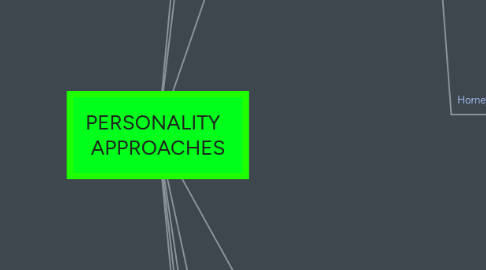
1. Historical Perspectives
1.1. Hippocrates
1.1.1. Choleric: someone passionated
1.1.2. Melancolic: someone anxious and unhappy
1.2. Franz Gall
1.2.1. Phrenology
2. Psychodynamic Perspective
2.1. Psychosexual development
2.1.1. Oral 0-1
2.1.2. Anal 1-3
2.1.3. Phallic (genitals ) 3-6
2.1.4. Latency ( none) 6-12
2.1.5. Genital 12+
2.2. Unconscious
2.2.1. EGO: maybe we can compromise
2.2.2. Superego: It´s not right to do that
2.2.3. Id: I want to do that now
2.3. Defens mechanism
2.3.1. Denial
2.3.2. Displacement
2.3.3. Projection
2.3.4. Rationalization
2.3.5. Reaction Formation
2.3.6. Regression
2.3.7. Repression
2.3.8. Sublimation
3. Behavioral Perspective
3.1. Skinner
3.1.1. Nurture over nature
3.1.1.1. Personality traits are not inborn
3.1.1.1.1. Personality is shaped by actions
3.1.1.2. Behave on prior learning
3.1.2. Cognite processes,behavior and context influencing by others simultaneously.
3.1.3. Personality develops over our entire life not only the first few years
3.1.4. Behave in a certain way
3.1.4.1. Increasing the ones that lead to positive results
3.1.4.2. Decrease the ones that don't
3.2. Bandura (social-cognitive)
3.2.1. Reciprocal Determinism
3.2.2. Observational Learning
3.2.2.1. Learning new behavior patterns when we see others performing them.
3.2.3. Self- Efficacy
3.2.3.1. Our level of confidence in our abilities to approach challenges and reach goals.
4. Biological Approaches
4.1. Minessota
4.1.1. Twins even when they are separated they have pretty similar personalities.
4.2. Physical proportions
4.2.1. Endomorph
4.2.1.1. solid torso, low levels fat, very sociable, fun and relaxed
4.2.2. Mesomorph
4.2.2.1. Equilibrated body, athletic, energetic, likes sports and adventures
4.2.3. Ectomorph
4.2.3.1. tall, thin, weak, very emotional, easy changes of humor
5. Neo-Freudians
5.1. Adler
5.1.1. Inferiority Complex
5.1.1.1. People were motivated by feelings of inferiority in childhood.
5.1.2. Social tasks
5.1.2.1. Occupational tasks
5.1.2.2. Societal tasks
5.1.2.3. Love tasks
5.1.3. Theory of birth order
5.1.3.1. The youngest will be spoiled
5.1.3.2. The middle ones will help both get along
5.1.3.3. Older siblings will be overachievers
5.2. Erikson
5.2.1. Interpersonal relationships are more important that sexual energy
5.2.2. Stages of psychosocial crisis
5.2.2.1. autonomy vs. shame (will9 1-3
5.2.2.2. initiave vs. guilt (purpose) 3-5
5.2.2.3. industry vs. inferiority ( competency ) 5-12
5.2.2.4. identy vs. role confusión (fidelity) 12-18
5.2.2.5. intimacy vs. isolation (love) 18-40
5.2.2.6. generativity vs. stagnation (care) 40-65
5.2.2.7. ego integrity vs. despair (wisdom) 65+
5.2.2.8. trust vs. mistrust ( hope) 0-1
5.3. Jung
5.3.1. The collective unconscious is a universal version of the unconscious
5.3.1.1. Mental patterns or memory traces
5.3.1.1.1. These ancestral memories are called archetypes
5.3.2. 2 attitudes or approaches towards life
5.3.2.1. Introversion
5.3.2.2. Extroversion
5.3.3. The focus of analytical psychology is on working to balance opposing forces of conscious and unconscious thought and experience within ones personality.
5.4. Horney
5.4.1. Each individual has the potential for self-realization.
5.4.2. Copying styles
5.4.2.1. Moving against people
5.4.2.1.1. Agression and manipulation
5.4.3. Moving towards people
5.4.3.1. Afiliation and dependence
6. Humanistic Approaches
6.1. Masiow
6.1.1. Hierarchy of needs theory
6.1.1.1. Self actualization
6.1.1.2. Esteem needs
6.1.1.3. Love needs
6.1.1.4. Safety needs
6.1.1.5. Physiologycal needs
6.2. Carl Rogers
6.2.1. He divided the self into ideal self and real
6.2.1.1. Ideal- the person you world like to be.
6.2.1.2. Real- the person you actually are
6.2.2. We experience congruence when our thoughts about our real self and ideal self are very similar.
6.2.2.1. High congruence leads to a greater sense of a healthy and productive life
6.2.3. We experience incongruence when there is a discrepancy between our ideal and attitude.
6.2.3.1. Incongruence can lead to maladjustment.
7. Traits Approach
7.1. The Five Factor Model (OCEAN)
7.2. Openness: High.curios, independent. Low-practical and conventional
7.3. conscientiousness: High-hardworking, organized, low- impulsive and careless
7.4. Extroversion: High- outgoing warm, low- quiet and reserved
7.5. Agreeableness: high- helpful and empathetic, low uncooperative
7.6. Neurotism: High- anxious, unhappy low calm, secure
8. Cultural Understanding
8.1. Universal
8.1.1. Some personality traits don't depend on culture
8.2. Culture- Specific
8.2.1. Asia- collectivism
8.2.2. Central and South American- openness
8.2.3. European - neuroticism
8.3. Study Approaches
8.3.1. Cultural - Comparative
8.3.2. Indigenous
8.3.3. Combines
